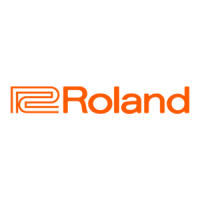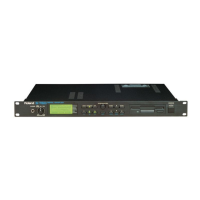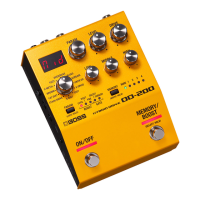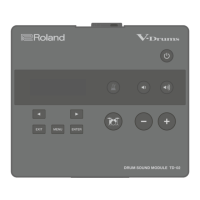56
Appendix
Using NRPN messages with a GS sound generator
There is an extended range of Control Change messages called NRPN (Non-
registered Parameter Number). GS sound generators can use these NRPN messages
to adjust sound parameters such as vibrato, filter, and envelope. This allows you to
use relatively simple and compact Control Change messages to modify the sound,
instead of using complex System Exclusive data (p. 51). The controller number is a
number used to specify the function of these Control Change messages.
The MIDI specification does not define the functions that can be assigned to NRPN.
NRPN is an extended range to which parameters unique to a device or performance
expression parameters can be assigned. In contract, RPN (Registered Parameter
Number) is an extended range of Control Changes whose function is defined by the
MIDI specification (p. 52).
To use NRPN, you first use the combination of NRPN MSB (controller number 99)
and NRPN LSB (controller number 98) to specify a function (sound parameter), and
then transmit a Data Entry (controller number 6) message to modify the value of the
specified sound parameter.
The MIDI implementation gives the combination of NRPN values (for GS sound
generators) in hexadecimal notation, but a table converted into decimal notation is
given below.
As an example, we will explain how to change the TVF cutoff frequency (one of the
functions listed above). First specify the function to be controlled (TVF cutoff
frequency) by the combination of NRPN MSB and NRPN LSB. NRPN MSB is
controller number 99, and NRPN LSB is controller number 98.
Transmit the following:
Controller number 99, value of 1
Controller number 98, value of 32.
This will specify the TVF cutoff frequency. Next, use the Data Entry Control Change
to specify the value (xx) of the TVF cutoff frequency.
ticks at TPQN=480).
Controller number 6 with a value of xx.
When you transmit this value, the TVF cutoff frequency will change, adjusting the
tone of the instrument selected for that part.
NRPN
MSB
NRPN
LSB
Value
range
Function
1 8 0 - 64 - 127 Vibrato rate *1
1 9 0 - 64 - 127 Vibrato depth *1
1 10 0 - 64 - 127 Vibrato delay *1
1 32 0 - 64 - 127 TVF cutoff frequency *1
1 33 0 - 64 - 127 TVF resonance *1
1 99 0 - 64 - 127 TVF&TVA envelope attack time *1
1 100 0 - 64 - 127 TVF&TVA envelope decay time *1
1 102 0 - 64 - 127 TVF&TVA envelope release time *1
24 rr 0 - 64 - 127 Drum instrument pitch coarse *1
Adjust the pitch for each percussion instrument of the
drum part.
26 rr 0 - 127 Drum instrument TVA level
Adjust the volume for each percussion instrument of the
drum part.
28 rr 0, 1 - 64 -
127
Drum instrument panpot
Adjust the pan for each percussion instrument of the
drum part. 0 is random, 1 is far left, 127 is far right.
29 rr 0 - 127 Drum instrument reverb send level
Adjust the reverb depth for each percussion instrument
of the drum part.
30 rr 0 - 127 Drum instrument chorus send level
Adjust the chorus depth for each percussion instrument
of the drum part.
31 rr 0 - 127 Drum instrument delay send level
Adjust the delay depth for each percussion instrument
of the drum part (only for SC-88/SC-88Pro/SC-8850/
SC-8820/SC-D70).
